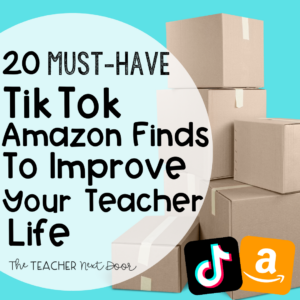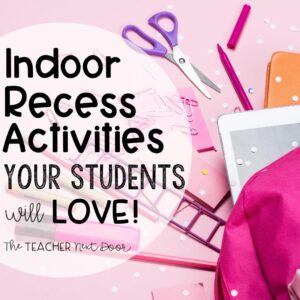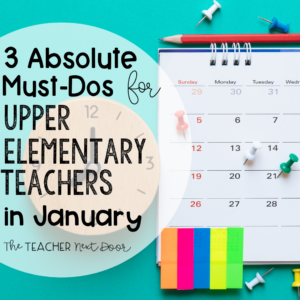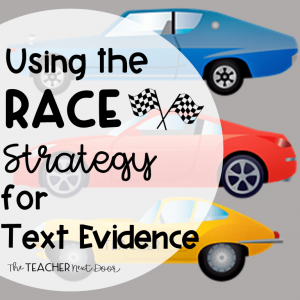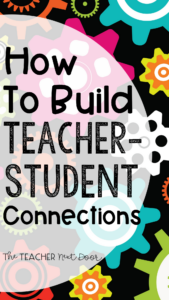
When students feel that they are valued and that their teacher cares about them, it makes a huge difference in the way they view the classroom, and how they feel about school.
As teachers, we often read about different strategies to help us become more effective teachers and to help students achieve to the highest of their abilities. While this is important, sometimes relationship building is downplayed as a less important aspect of being a teacher.
In reality, it serves as the foundation for everything else. According to Marzano, Pickering, and Hefelbower in 2010, “Building relationships with students improves student achievement.”
Making connections with students has always been very important to me. I’d love to share with you some of the ways I build relationships with my students.
1. Greet Students at the Door
I always make it a point to greet each student as he/she walks into the classroom. Some teachers add a hug, high five, or a special handshake. All of these are great but I keep it simple and just stand there with a big ol’ smile, welcoming each child, patting arms or backs, and chatting as they walk through the door.
This is a great chance to notice a student’s new haircut or new glasses, to ask about a bandaged knee, or how the soccer game went. Little connections and tiny moments add up to a lot when this is repeated day after day. I love the way too that it shows students that I’m glad to see them and am looking forward to the day. It sets the tone for a positive day.
2. Get to Know Your Students
There’s a difference between knowing students as learners and knowing them as human beings. If we really want to make those connections, we’ve got to make the effort as teachers to find out about our students’ interests. This can be done in a number of ways.
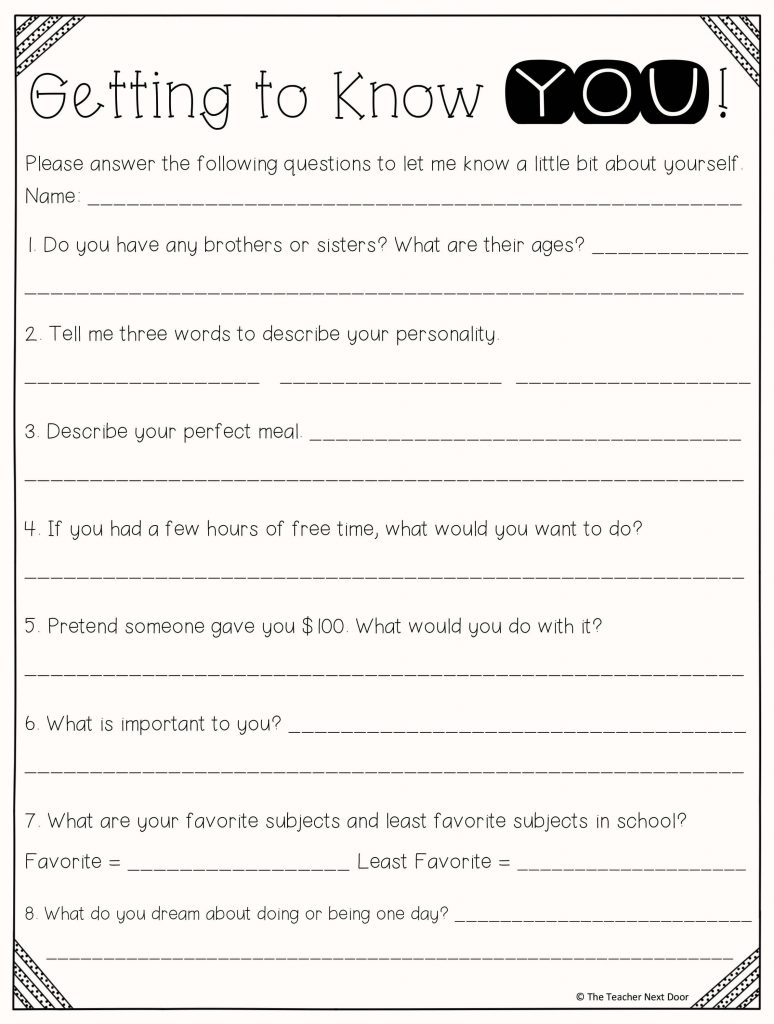
On the very first day of school, I have students fill out a Getting to Know You Survey and an All About Me page from my Back to School packet. It tells me some of their likes and dislikes and is a good place to start.
You can download this FREE Getting to Know You page now by clicking here.
On Back to School Night, which is about a week after school starts, I give parents a confidential questionnaire that asks them about their child’s strengths, areas of difficulty, their goals for their child for the year, and any special concerns that I need to know.
Parents are surprisingly candid on these forms and the information I get makes a huge difference in my understanding of that child. It also serves as a reminder (whether I need one or not) that this child is precious to his/her parents and that they feel about their child how I feel about my child. It strengthens those beginning bonds that are already forming.
3. Incorporate Student Interests Into Lessons
Once you’ve gotten to know your students, it’s really fun to include some of that information into lessons, wherever it fits. In math, we do lots of word problems and I practically have students beg me to use them in the practice problems we do.
It is actually really cute how much they like it and it keeps them engaged. For example, if a student (Aidan) is crazy about sloths, I might start a word problem like this… Aidan was a zookeeper and was a sloth specialist. If each of the 8 sloths was fed .35 lb. of leaves each day, how many pounds of leaves does Aidan feed all of the sloths each day?
It also works really well for grammar lessons too! One note is that I do have kids raise their hands to participate and would never include a child in a lesson if he/she didn’t want to be included. I make it a point never to “zing” kids or to put them on the spot. This is one way to give each child space and respect.
4. Check-in With Each Child Every Day
Sometimes when we have so many students in our class, we may think of our students as a collective group, like “the whole class” rather than as individual kids. I think this happens more often when we’re feeling extra stressed from the demands of testing, or paperwork, or administration, or difficult parents, or challenging students.
There’s a real danger in this mentality though. We’ve got to make up our minds to make it a daily goal to see our class as individual students and to personally speak to each child at least once a day, in a positive way.
This really hits home for me because I think we have to be especially careful not to give less attention to kids who are doing well and who have no major behavior problems.
It makes me think back to myself as a small child. I was a strong student but very quiet in the classroom. I was one of those good kids who is often overlooked. In fact, I could have easily been invisible at school, were it not for some really caring teachers along the way who noticed me and made me feel valued.
One of the ways I make sure this happens is to constantly walk around the room during independent work times. I have never had a problem getting my steps in each day because I truthfully rarely sit down! As I walk around, I quietly speak to students and may comment about a number of things from a simple, “How are you doing?” to “How did your dance recital/soccer practice/basketball game go this weekend?” I may ask about their dog or their new brother or sister.
The point is that when we have these mini-conversations, we’re building bridges in relationship connections.
5. Be Respectful
From the very first day on, I try to create a warm, family-type atmosphere in my classroom. I want to make it a place where all of my students feel accepted and feel comfortable.
Part of creating this kind of caring classroom is based on treating students with respect, no matter what’s going on or how I’m feeling. I make sure to never raise my voice, to never call on kids intentionally when I know they don’t know the answer, or to belittle a child in any way.
When students know that I have their best interests at heart and am supportive of them whether I agree with everything they’re doing or not, it builds respect between us, as well as trust. Kids need a predictable teacher in this regard.
Also, one of the benefits of giving students respect, is that on the whole, students show me respect in return.
6. Be Real
Getting to know students is definitely important but it’s also a good idea to allow students to get to know you too. By sharing your interests, your children, your pets, or your childhood, you’re allowing kids to know you a little bit better as a person, and not just a teacher.
One of my favorite times for sharing about myself is during spelling tests. The words on the list spark my ideas and I find myself on a pleasant bunny trail, talking about my life or even some interesting tidbit which relates to the word the students are spelling!
Also, part of being real is that we make mistakes too. In fact, I freely admit it when this happens. Having an attitude of we all make mistakes and we learn from them and move on, is a great life lesson we can teach in the classroom.
7. Have Some Fun
One of my goals is to make my classroom a place where kids want to come and where they enjoy spending time. Boredom to me is the kiss of death in the classroom, so I do my best to keep things moving and to keep things fun whenever possible (it’s usually possible).
Having a good sense of humor is crucial for teachers too! I don’t mean that you have to tell jokes like a stand-up comedian, but you merely need to see the humor in things, you need to be able to acknowledge it, and you need to be able to laugh with your students.
Everyone enjoys a good laugh and it definitely brightens the school day and builds connections with students and teachers. Being silly too is such a gift for educators. I’ll admit, there’s an art to this. You have to know how to be silly, but also know how to reign kids back into whatever you’re focusing on. The silly part is so delicious though, that I think it’s worth it!
8. Show Students You Care
There are so many ways to do this but when students know that you truly care for them, it can strengthen teacher-student connections.
Research has proven this to be true. “Demonstrating caring is one of the most powerful ways to build positive relationships with your students.” (Kerman, et al., 1980)
By reaching out to students who are feeling down, who are struggling in a certain subject, who are in desperate need of making friendships in their peer group, who are suffering from some kind of trauma…you are showing that you care. We may not be able to solve all of our student’s problems but by simply showing them that we are here for them, are supportive of them, and want to help, that means a lot.
9. Have Morning Meetings
Morning Meetings go a long way toward creating a positive classroom climate. They also foster relationships with students to their classmates and to you. This day to day time of meeting together to share social-emotional lessons together makes a real difference in the behavior and the tone of the class.
If you’d like to read more about how I organize Morning Meetings, here’s a post I wrote that you might like: Morning Meetings in the Classroom.
Thanks so much for stopping by!


